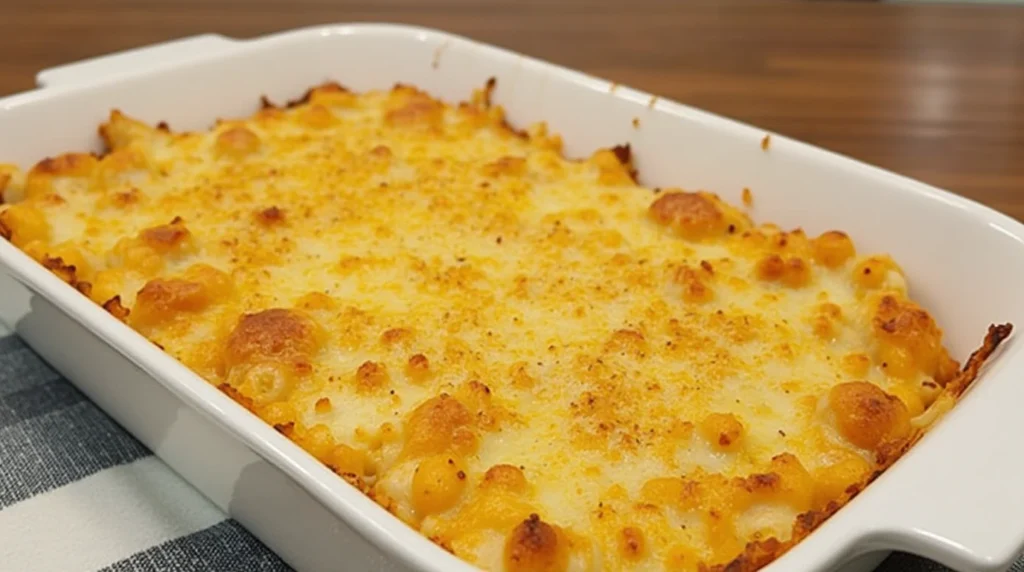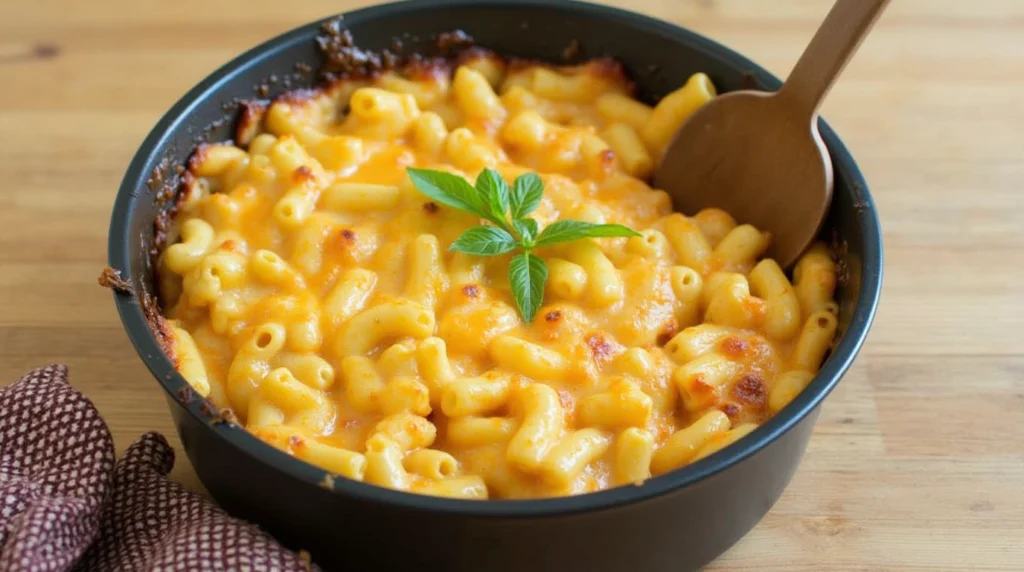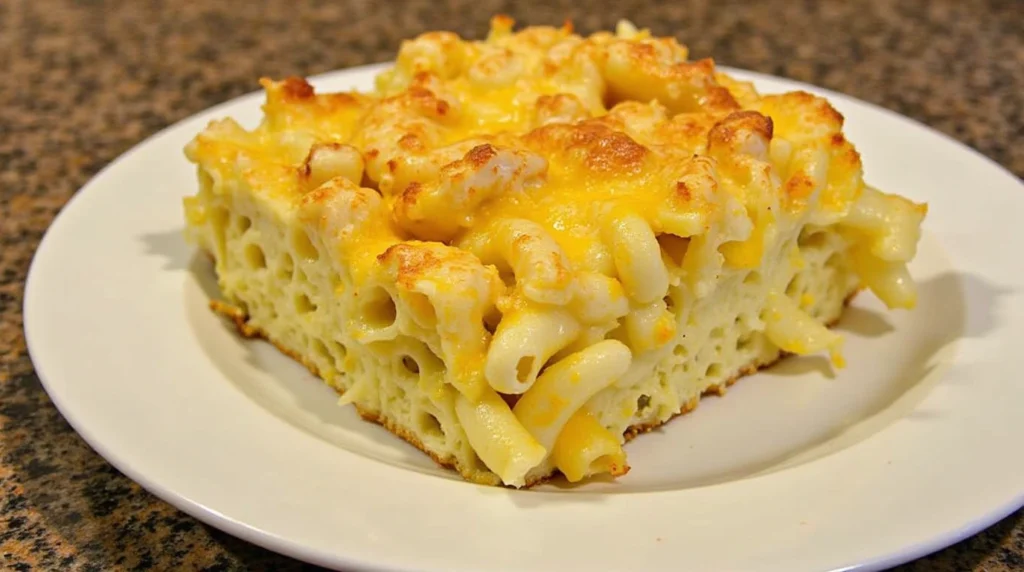Opening: A Taste of Nostalgia

There’s something deeply comforting about a spoonful of hot, cheesy baked mac — creamy, golden, and bubbling fresh from the oven. Maybe it reminds you of family dinners, late-night cravings, or a cozy night in when you needed a little edible hug. But here’s the thing: not all mac and cheese is created equal — and the cheese you choose can either elevate your dish to unforgettable or leave it bland and boring.
If you’ve ever wondered why some macs taste ultra-rich and gooey while others fall flat, you’re in the right place. Let’s uncover what cheese really belongs in the best mac and cheese — and how to craft a cheesy baked mac that’s worthy of center stage at your dinner table.
Why Cheese Choice Matters in Mac and Cheese
Understanding cheese is the first step to mastering mac and cheese.
Flavor Profile – From Mild to Sharp
- Sharp cheeses (like aged cheddar) pack more flavor punch.
- Mild cheeses (like mozzarella) add texture but not much depth.
- Combining different flavor strengths creates balance and complexity.
Texture and Meltability
- Not all cheeses melt equally — and that matters.
- Best melters: Gruyère, Monterey Jack, Fontina, Mozzarella.
- Poor melters: Feta, Goat Cheese, Paneer (avoid in classic mac).
Creaminess vs. Crumbliness
- Soft cheeses = smooth sauces (cream cheese, Brie).
- Hard cheeses = stronger structure, great for topping (Parmesan).
The Role of Cheese in Sauce Binding
- Cheese binds with béchamel to create that velvety, clinging texture.
- Overheating can cause curdling or oil separation — avoid boiling.
The Best Cheeses for Classic Mac and Cheese
Here are tried-and-true cheeses that make your mac unforgettable.
Cheddar – The Traditional Favorite
- Rich, familiar, melts well.
- Sharp or extra-sharp gives better flavor depth.
Gruyère – Nutty and Melty
- Ideal for a more gourmet profile.
- Blends beautifully with cheddar for a creamy bite.
Parmesan – For a Flavor Kick
- Adds salty, umami-rich finish.
- Best used in moderation or sprinkled on top.
Cream Cheese – For Extra Creaminess
- Thickens sauce without flour.
- Great for extra-smooth texture.
Table: Classic Cheese Blend for Baked Mac
| Cheese | Flavor Strength | Melting Ability | Best Used For |
|---|---|---|---|
| Cheddar | Medium-Strong | Excellent | Base flavor & texture |
| Gruyère | Nutty | Excellent | Smooth sauce enhancement |
| Parmesan | Salty, Sharp | Low | Topping or finishing kick |
| Cream Cheese | Mild | High | Extra creaminess |
Creative Cheese Combinations for Next-Level Flavor
Why stick to one when you can blend for brilliance?
Mozzarella and Gouda for Stretch and Sweetness
- Mozzarella adds stretch.
- Gouda melts like butter and adds sweetness.
Monterey Jack and Cheddar for Balanced Flavor
- Mild meets sharp.
- Smooth, reliable melting combo.
Velveeta – Smooth and Kid-Friendly
- Processed, yes — but ultra-smooth and creamy.
- Ideal for quick stovetop mac or picky eaters.
Mixing Hard and Soft Cheeses
- Try a 3-cheese blend: cheddar (base), mozzarella (melt), parmesan (punch).
- Don’t forget cream cheese or mascarpone for ultra-smooth texture.
Homemade vs. Store-Bought: How Cheese Selection Differs
Not all mac and cheese comes from scratch — and that affects your flavor.

What’s in Kraft Mac and Cheese?
- Powdered cheese blend (typically cheddar-based).
- Less flavor complexity but lots of nostalgia.
Shelf-Stable Cheese vs. Fresh Cheese
- Boxed mac uses preservatives for long life.
- Fresh cheese has better flavor, texture, and melt.
Flavor Depth in Homemade Versions
- You control salt, spice, fat, and cheese balance.
- Opportunity to experiment with herbs, garlic, mustard powder.
Ingredient Control and Customization
- Add bacon, jalapeños, broccoli, or hot sauce.
- Use gluten-free pasta or dairy-free cheese alternatives if needed.
Tips for the Perfect Cheese Sauce
Perfect mac and cheese isn’t just about the cheese — it’s about the method too.
How to Make a Roux and Béchamel Base
- Start with equal parts butter and flour, cook until golden.
- Add milk gradually to create a béchamel sauce — this is your base.
Melting Cheese Properly Without Curdling
- Lower the heat when adding cheese.
- Stir constantly — don’t rush.
Avoiding Grainy Texture in Sauce
- Avoid pre-shredded cheese (contains anti-caking agents).
- Grate fresh cheese for smoother melting.
Using Milk, Butter, and Pasta Water Wisely
- Whole milk or cream = richer sauce.
- Pasta water adds starch to help bind everything together.
Nutritional Value of Cheeses in Mac and Cheese
Understanding what’s on your plate goes beyond taste.
Calories and Fat Content
- Cheddar and Gruyère are high in saturated fat — flavorful but rich.
- Lighter options include part-skim mozzarella and low-fat cream cheese.
Protein Power
- Cheese adds a solid protein boost, especially hard cheeses like Parmesan.
- Pair with whole wheat pasta for a more balanced mac.
Sodium Levels
- Processed cheeses (Velveeta, American) are often high in sodium.
- Use fresh cheese and season yourself to control salt intake.
Cheese Substitutes for Dietary Needs
Whether you’re dairy-free, vegan, or lactose-sensitive, you can still enjoy cheesy comfort.
Vegan Cheese Alternatives
- Nutritional yeast + plant milk + cashews = creamy vegan base.
- Brands like Daiya or Violife offer meltable vegan cheeses.
Lactose-Free Cheese
- Many aged cheeses like cheddar and Swiss are naturally low in lactose.
- Lactose-free milk and cheese brands (e.g., Green Valley Creamery) work great in sauces.
Gluten-Free Mac and Cheese
- Use gluten-free pasta (brown rice, lentil, or chickpea).
- Thicken sauces with cornstarch or gluten-free flour for roux.
Popular Variations of Cheesy Baked Mac
Take your cheesy baked mac from ordinary to unforgettable with these delicious twists:
Southern-Style Baked Mac
- Extra creamy and heavily seasoned.
- Often includes eggs and evaporated milk for custard-like finish.
Truffle Mac and Cheese
- Add a drizzle of truffle oil or truffle-infused cheese like truffle cheddar.
- Elegant, earthy, and perfect for dinner parties.
Buffalo Chicken Mac
- Toss shredded chicken in buffalo sauce, blend with blue cheese and cheddar.
- A spicy, tangy spin on the classic.
Lobster Mac and Cheese
- Use a white cheddar and gruyère blend for richness.
- Stir in chunks of buttery lobster tail — the ultimate indulgence.
Table: Cheese Alternatives and Pairing Ideas
| Dietary Need | Cheese Alternative | Best For |
|---|---|---|
| Vegan | Cashew + Nutritional Yeast | Creamy vegan cheese sauce |
| Lactose-Free | Aged Cheddar, Swiss | Same flavor, low-lactose option |
| Low-Fat | Part-skim Mozzarella | Lighter baked mac |
| Gluten-Free | GF Flour, Pasta | Roux and pasta base replacement |
What Pasta Pairs Best with Mac and Cheese?
Cheese isn’t everything — pasta shape matters, too.
Elbow Macaroni – The Classic Choice
- Curves hold cheese sauce perfectly.
- Small and familiar, ideal for traditional comfort food.
Shells – Sauce Catchers
- Great for thick cheese sauces.
- Mini or medium shells add texture and interest.
Cavatappi – Twists of Texture
- Corkscrew shape holds cheese and adds bite.
- Excellent for baked mac and cheese versions.
Penne or Fusilli – Non-Traditional but Delicious
- Great when mixing with proteins or veggies.
- Sturdier pasta adds chewiness.

Serving Ideas and Side Dishes
Make your cheesy baked mac the star of the plate — or part of a comforting spread.
Best Proteins to Serve With
- Grilled chicken, BBQ pulled pork, or crispy bacon.
- Fried chicken or meatloaf for Southern flair.
Vegetable Pairings
- Roasted broccoli, Brussels sprouts, or sautéed kale.
- Fresh side salad with vinaigrette balances richness.
Baked Toppings for Texture
- Breadcrumbs toasted in butter or garlic.
- Crushed Ritz crackers or panko for extra crunch.
How to Store and Reheat Mac and Cheese Properly
Refrigeration Tips
- Store in airtight container for up to 4 days.
- Add a splash of milk before reheating to revive creaminess.
Freezing for Later
- Freeze in portions.
- Reheat slowly in oven or stovetop to preserve texture.
Best Reheating Methods
- Oven: Best for baked versions (325°F, covered, 15–20 min).
- Microwave: Add milk, stir halfway through.
- Stovetop: Add butter, milk; reheat low and slow.
A Warm Hug in a Bowl
Let’s face it—there’s something magical about a bowl of cheesy baked mac. It’s more than just pasta and cheese; it’s comfort food at its finest, a nostalgic throwback to childhood, or a creamy indulgence after a long day. Whether you’re perfecting your family’s favorite or trying it for the first time, one question remains essential: what cheese is in mac and cheese? Because the secret to that melty, rich, soul-satisfying dish is all in your cheese choices.
If you’ve ever found your mac too greasy, too bland, or not creamy enough—don’t worry. You’re about to learn how to turn simple ingredients into a gooey, golden, flavor-packed masterpiece. Let’s dive deep into the cheeses that make mac and cheese truly shine.
Why Cheese Choice Matters in Mac and Cheese
Your choice of cheese can make or break your cheesy baked mac. It’s not just about melting—it’s about flavor, texture, and how all the components work together for that perfect bite.
Flavor Profile – From Mild to Sharp
- Milder cheeses like mozzarella offer stretchy texture but not much punch.
- Sharp cheddar, gruyère, and aged gouda bring bold flavor and complexity.
- Blending is key—combine a sharp cheese with a mellow one for balance.
Texture and Meltability
- Not all cheeses melt well! You want ones that become smooth—not stringy or oily.
- Good melters: Cheddar, gruyère, fontina, Monterey Jack, mozzarella.
- Avoid crumbly cheeses like feta unless you’re going for a specific effect.
Creaminess vs. Crumbliness
- Creamy cheeses (like cream cheese, brie) create a luxurious sauce.
- Hard, crumbly cheeses (like Parmesan) add depth but need to be combined wisely.
The Role of Cheese in Sauce Binding
- A proper cheese sauce binds to your pasta, not puddle at the bottom.
- Use a béchamel base to help cheese emulsify and stick beautifully.
The Best Cheeses for Classic Mac and Cheese
You can’t go wrong with these tried-and-true cheeses that elevate classic mac to gourmet levels.
Cheddar – The Traditional Favorite
- Sharp white or yellow cheddar is a staple.
- Melts beautifully and brings that signature mac and cheese flavor.
Gruyère – Nutty and Melty
- Adds a luxurious, slightly nutty flavor.
- Perfect for baked mac and cheese with a crispy top.
Parmesan – For a Flavor Kick
- Use sparingly—great as a topping or to sharpen a cheese blend.
- Adds a salty, umami kick.
Cream Cheese – For Extra Creaminess
- Helps create a silky smooth base.
- Mix in a few tablespoons for extra lusciousness.
Creative Cheese Combinations for Next-Level Flavor
Ready to experiment? These combinations take your cheesy baked mac up a notch.
Mozzarella and Gouda for Stretch and Sweetness
- Mozzarella brings gooey stretch.
- Smoked gouda adds a hint of sweetness and smokiness.
Monterey Jack and Cheddar for Balanced Flavor
- A smooth, creamy base with a gentle flavor.
- Crowd-pleasing and easy to work with.
Velveeta – Smooth and Kid-Friendly
- Processed cheese, but ultra-creamy and no risk of curdling.
- Great for picky eaters or nostalgic vibes.
Mixing Hard and Soft Cheeses
- Combine hard cheeses (Parmesan, Asiago) with soft melters (Jack, fontina).
- Texture and taste come alive in every bite.
Homemade vs. Store-Bought: How Cheese Selection Differs
What’s really in that box? Let’s compare homemade mac and cheese with its store-bought counterpart.
What’s in Kraft Mac and Cheese?
- Processed cheese powder (usually cheddar-based).
- Shelf-stable, easy, but not as rich or deep in flavor.
Shelf-Stable Cheese vs. Fresh Cheese
- Shelf-stable: more preservatives, less complexity.
- Fresh cheese: better melting, creamier, richer.
Flavor Depth in Homemade Versions
- Homemade versions allow full control of flavors.
- More layers: tangy, nutty, creamy, sharp—all in one bite.
Ingredient Control and Customization
- Avoid additives, preservatives, and excess sodium.
- Customize to suit dietary needs—vegan, low-fat, or gluten-free.
Tips for the Perfect Cheese Sauce
Here’s where your cheesy baked mac transforms from good to unforgettable.
How to Make a Roux and Béchamel Base
- Equal parts butter and flour, cooked until golden.
- Add milk slowly, stir constantly to create a silky base.
Melting Cheese Properly Without Curdling
- Always lower the heat before adding cheese.
- Stir gently—avoid boiling or high heat.
Avoiding Grainy Texture in Sauce
- Use freshly grated cheese.
- Don’t overheat or rush the process.
Using Milk, Butter, and Pasta Water Wisely
- Milk and butter enrich the sauce.
- Pasta water adds starch and helps the sauce cling to noodles.

Nutritional Insights of Cheeses in Mac and Cheese
Understanding what’s on your plate helps you make smarter choices—whether you’re aiming for indulgence or balance.
Calories and Fat Content by Cheese Type
| Cheese Type | Calories (1 oz) | Total Fat | Protein | Notable Nutrients |
|---|---|---|---|---|
| Cheddar | ~115 | 9g | 7g | Calcium, Vitamin A |
| Gruyère | ~117 | 9g | 8g | Phosphorus, B12 |
| Cream Cheese | ~99 | 10g | 2g | Vitamin A |
| Parmesan | ~110 | 7g | 10g | Calcium, Zinc |
| Mozzarella | ~85 | 6g | 6g | Low in sodium (if fresh) |
| Velveeta (processed) | ~80 | 6g | 4g | Often high in sodium |
Tip: Mixing high-flavor cheeses (like Parmesan) with low-fat options (like part-skim mozzarella) helps reduce overall fat while keeping bold taste.
Cheese Swaps for Dietary Preferences
Don’t worry if you’re lactose-intolerant, vegan, or trying to cut calories—you can still enjoy rich, creamy cheesy baked mac.
Lactose-Free Cheese Alternatives
- Brands like Cabot offer lactose-free cheddar.
- Look for hard, aged cheeses (natural low-lactose content).
Vegan Cheese Options
- Cashew-based or coconut-oil-based cheese alternatives.
- Nutritional yeast adds a cheesy, umami flavor to sauces.
- Brands to try: Violife, Daiya, Miyoko’s.
Low-Fat Cheese Ideas
- Part-skim mozzarella or reduced-fat cheddar.
- Use Greek yogurt or low-fat cream cheese in the sauce.
Popular Variations of Cheesy Baked Mac
Once you’ve nailed the base recipe, try these exciting spins on your classic.
Southern Baked Mac and Cheese
- Extra cheddar, evaporated milk, and a breadcrumb topping.
- Often baked until golden and crispy.
Mac and Cheese with Bacon and Jalapeños
- Smoky and spicy—perfect for adult palates.
- Top with panko for crunch.
Truffle Mac and Cheese
- Add a splash of truffle oil or shavings of truffle cheese.
- Elevates the dish to restaurant-level status.
Buffalo Chicken Mac
- Spicy buffalo sauce, shredded rotisserie chicken, blue cheese crumbles.
- Tangy, spicy, and seriously indulgent.
Conclusion: Build Your Best-Ever Cheesy Baked Mac
You now know the secret: the perfect cheesy baked mac isn’t just about tossing any cheese into a pot. It’s about balancing flavors, textures, and techniques to get that creamy, crave-worthy dish you can be proud of. Whether you keep it classic with cheddar or jazz it up with Gruyère and Gouda, your mac and cheese can be the centerpiece of any meal.
Ready to level up your mac game? Go forth and blend cheeses like a pro. Your taste buds will thank you.
FAQ: What Cheese Is in Mac and Cheese?
What’s the best cheese to use in mac and cheese?
Cheddar is the go-to, but combining it with Gruyère, Parmesan, or Monterey Jack makes the dish more flavorful and creamy.
Can I use pre-shredded cheese?
You can, but fresh-grated cheese melts smoother because pre-shredded varieties contain anti-caking agents.
Is Velveeta real cheese?
Velveeta is processed cheese, designed for ultra-smooth melting. It’s not the most natural option, but it’s great for creamy stovetop versions.
What cheese combinations are best for baked mac and cheese?
Try a 3-cheese blend like sharp cheddar, mozzarella, and parmesan — or get creative with smoked Gouda and cream cheese for deeper richness.
